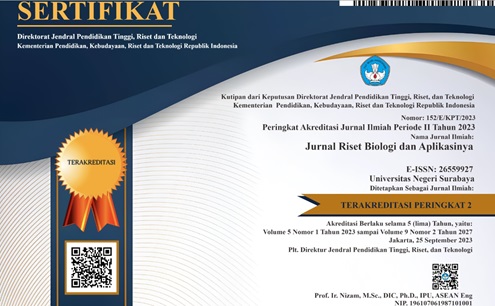Filicinae Taxonomic Diversity in the Tourism Area of Tretes Waterfall Wonosalam Kabupaten Jombang
DOI:
https://doi.org/10.26740/jrba.v4n2.p57-68Keywords:
Dominan diversity, Filicinae, Taxonomy diversity, Tretes WaterfallAbstract
Filicinae is a fern with the most species members. The Filicinae includes approximately 170 genera and 7000 species. Filicinae grows in wet, humid, and shady environmental conditions, like waterfall areas with an altitude of 1100-1300 meters above sea level (m a s l). The study aimed to determine the taxonomic diversity of the Filicinae in the Tretes Wonosalam Waterfall Tourism area. Taxonomic diversity is very important in tourism areas because it prevents species extinction due to the destruction of the habitat, they live in. This was descriptive research with exploration and observation techniques used purposive sampling methods based on altitude. The results of the study were stated in the form of an inventory list of species and families of each station. Data gained of species diversity were analyzed using taxonomic diversity with the formula (?) and dominance diversity with the formula (?*). Exploration results found 37 species from 12 families composed of 10 species from 7 families at station 1; 12 species from 6 families at station 2; 14 species from 7 families at station 3; and 22 species from 12 families at station 4. The highest taxonomic diversity (?) was station 4 with 106.8 while the lowest for station 1 was 25.63. Dominance diversity (?*) at all stations in this study was in the medium category. The highest family found in the study was Tectariaceae with six species.
References
Brownsey, P. J., & Perrie, L. R. (2014). Flora of New Zealand Ferns and Lycophytes (Issue December). New Zaeland: Manaaki Whenua Press
Cousins, S.H. 1994. Taxonomy and functional biotic measurement, or, will the Ark work? In Systematics and Conservation Evaluation, Forey PL, Humphries CJ, Vane-Wright RI. (eds). Oxford: Claderon Press
Darajati, W., Pratiwi, S., Herwinda, E., Radiansyah, A. D., Nalang, V. S., Nooryanto, B., Rahajoe, J. S., Ubaidillah, R., Maryanto, I., Kurniawan, R., Prasetyo, T. A., Rahim, A., Jefferson, J., & Hakim, F. (2016). Indonesia Biodiversity Startegy and Action Plan (IBSAP) 2012-2020. Kemetrian Pembangnan Nasional/BAPPENAS
Efendi, W.W., & Iswahyudi, S. (2019). Keanekaragaman Tumbuhan Paku di Jawa Timur. Surabaya: Graha Ilmu
Efendi, W.W., Hapsari, F.N.P., dan Nuraini, Z. (2013). Studi Inventarisasi Keanekaragaman Tumbuhan Paku Di Kawasan Wisata Coban Rondo Kabupaten Malang. Cogito Ergo Sum, 2(3), 173. http://eprints.umm.ac.id/26645/1/jiptummpp-gdl-wawanwahyu-31552-1-pendahul-n.pdf
Holtum, (1968). Ferns of Malaya. Toronto: Mc Grawhill
Lubis, S. R. (2009). Keanekaragaman dan Pola Distribusi Tumbuhan Paku Di Hutan Wisata Alam Taman Eden Kabupaten Toba Samosir Provinsi Sumatera Utara. Tesis. Medan: Sekolah Pascasarjana Universitas Sumatra Utara
New, T. (1995). An Introduction to Invertebrate Conservation Biology. New York: Oxford University Press
Wang, C.H., dan Wu, S.H. 1999. For a Reipublicae Popularis Sinicae (in Chinese). Beijing: Science Press
Downloads
Published
How to Cite
Issue
Section
License
Copyright (c) 2022 Jurnal Riset Biologi dan Aplikasinya

This work is licensed under a Creative Commons Attribution-NonCommercial 4.0 International License.
 Abstract views: 438
,
Abstract views: 438
, PDF Downloads: 1228
PDF Downloads: 1228












